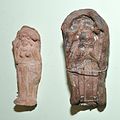 Front view of the Museum in Mathura | |
 | |
| Established | 1874 |
|---|---|
| Location | Mathura |
| Key holdings | Mudgarpani Agnipani ContentsBhutesvara Yakshis |
| Founder | Frederic Growse |
| Director | Shiv Prashad Singh |
Government Museum, Mathura, commonly referred to as Mathura museum, is an archaeological museum in Mathura city of Uttar Pradesh state in India. The museum was founded by then collector of the Mathura district, Sir F. S. Growse in 1874. Initially, it was known as Curzon Museum of Archaeology, then Archaeology Museum, Mathura, and finally changed to the Government Museum, Mathura. [1]





























